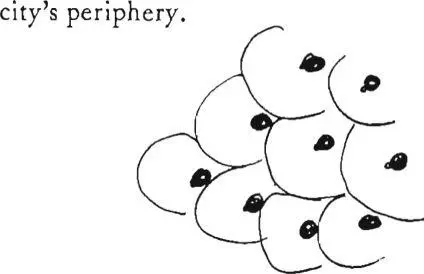Christopher alexander - A pattern language
Здесь есть возможность читать онлайн «Christopher alexander - A pattern language» весь текст электронной книги совершенно бесплатно (целиком полную версию без сокращений). В некоторых случаях можно слушать аудио, скачать через торрент в формате fb2 и присутствует краткое содержание. Жанр: Прочая научная литература, на английском языке. Описание произведения, (предисловие) а так же отзывы посетителей доступны на портале библиотеки ЛибКат.
- Название:A pattern language
- Автор:
- Жанр:
- Год:неизвестен
- ISBN:нет данных
- Рейтинг книги:3 / 5. Голосов: 1
-
Избранное:Добавить в избранное
- Отзывы:
-
Ваша оценка:
- 60
- 1
- 2
- 3
- 4
- 5
A pattern language: краткое содержание, описание и аннотация
Предлагаем к чтению аннотацию, описание, краткое содержание или предисловие (зависит от того, что написал сам автор книги «A pattern language»). Если вы не нашли необходимую информацию о книге — напишите в комментариях, мы постараемся отыскать её.
A pattern language — читать онлайн бесплатно полную книгу (весь текст) целиком
Ниже представлен текст книги, разбитый по страницам. Система сохранения места последней прочитанной страницы, позволяет с удобством читать онлайн бесплатно книгу «A pattern language», без необходимости каждый раз заново искать на чём Вы остановились. Поставьте закладку, и сможете в любой момент перейти на страницу, на которой закончили чтение.
Интервал:
Закладка:
The pattern or patterns which could resolve these problems are, for the moment, unknown. We can hint at the kinds of buildings and land use and institutions which would bring the problem into balance. But the geometry cannot be understood until certain social facts are realized, and given their full power to influence the environment. In shorty until both men and women are able to mutually influence each fart of a town's life , we shall not know what kinds of fhysical fatterns will best co-exist ivith this social order.
Therefore:
*47
Make certain that each piece of the environment—each building, open space, neighborhood, and work community —is made with a blend of both men’s and women’s instincts. Keep this balance of masculine and feminine in mind for every project at every scale, from the kitchen to the steel mill.
| man’s spirit |  |
woman’s spirit |
No large housing areas without workshops for men; no work communities which do not provide for women with part-time jobs and child care— scattered work(9). Within each place which has a balance of the masculine and feminine-, make sure that individual men and women also have room to flourish, in their own right, distinct and separate from their opposites— a ROOM OF one’s OWN(141). . . .
both in the neighborhoods and the communities yand in between them yin the boundaries yencourage the formation of local centers:
| 28. | ECCENTRIC NUCLEUS |
| 29. | DENSITY RINGS |
| 30- | ACTIVITY NODES |
| 3 1- | PROMENADE |
| 3 2‘ | SHOPPING STREET |
| 33- | NIGHT LIFE |
| 34- | INTERCHANGE |
| I49 |
28 ECCENTRIC NUCLEUS*
. . . so far, we have established an overall height restriction on the city, with its attendant limitation on average density—four-story limit (21). If we assume, also, that the city contains major centers for every 300,000 people, spaced according to the rules in magic of the city (10), it will then follow that the overall density of the city slopes off from these centers: the highest density near to them, the lowest far away. This means that any individual community of 7000 (12) will have an overall density, given by its distance from the nearest downtown. The question then arises: How should density vary locally, within this community; what geometric pattern should the density have? The question is complicated greatly by the principle of subculture boundary (13), which requires that communities are surrounded by their services, instead of having their services at their geometric centers. This pattern, and the next, defines a local distribution of density which is compatible with this context.
The random character of local densities confuses the identity of our communities, and also creates a chaos in the pattern of land use.
Let us begin by considering the typical configuration of the residential densities in a town. There is an overall slope to the densities: they are high toward the center and lower toward the outskirts. But there is no recognizable structure within this overall slope: no clearly visible repeating pattern we can see again and again within the city. Compare this with the contours of a mountain range. In a mountain range, there is a great deal of recognizable structure; we see systematic ridges and valleys, foothills, bowls, and peaks which have arisen naturally from geological processes; and all this structure is repeated again and again, from place to place, within the whole.
150 28 ECCENTRIC NUCLEUS
Of course, this is only an analogy. But it does raise the question: Is it natural, and all right, if density configurations in a town are so random; or would a town be better off if there was some more visible coherent structure, some kind of systematic variation in the pattern of the densities?
What happens when the local densities in a town vary in their present rambling, incoherent fashion? The high density areas, potentially capable of supporting intense activity cannot actually do so because they are too widely spread. And the low density areas, potentially capable of supporting silence and tranquility when they are concentrated, are also too diffusely scattered. The result: the town has neither very intense activity, nor very intense quiet. Since we have many arguments which show how vital it is for a town to give people both intense activity, and also deep and satisfying quiet—sacred sites (24), activity nodes (30),
PROMENADE (31), QUIET BACKS (59), STILL WATER (71)-it
seems quite likely, then, that this randomness of density does harm to urban life.
We believe, indeed, that a town would be far better off if it did contain a coherent pattern of densities. We present a systematic account of the factors which might naturally influence the pattern of density—in the hope of showing what kind of coherent pattern might be sensible and useful. The argument has five steps.
1. We may assume, reasonably, that some kind of center, formed by local services, will occur at least once in every community of 7000. This center will typically be the kind we have called a shopping street (32). In web of shopping (19) we have shown that shopping streets occur about once for every 10,000 persons.
2. From the arguments presented in subculture boundary (13), we know that this center of activity, since it is a service, should occur in the boundary between subcultures, should help to form the boundary between subcultures, and should therefore be located in the area of the boundary—not inside the community, but between communities.
3. We know, also, that this center must be in just that part of the boundary which is closest to the center of the larger town or city. This follows from a dramatic and little known series of results which show that catch basins of shopping centers are not
circles, as one might naively suppose, but half-circles, with the half-circle on that side of the center away from the central city, because people always go to that shopping center which lies toward the center of their city, never to the one which lies toward the

Brennan's catch basins.
This phenomenon was originally discovered by Brennan in his post-war studies of Wolverhampton (T. Brennan, Midland City , London: Dobson, 1948). It has, since then, been confirmed and studied by several writers, most notably Terence Lee, “Perceived Distance as a Function of Direction in the City,” Environment and Behavior , June 1970, 40-51. Lee has shown that the phenomenon is not only caused by the fact that people are simply more familiar with the roads and paths that lie toward the center, and use them more often, but that their very perception of distance varies with direction, and that distances along lines toward the center are seen as much shorter than distances along lines away from the center.
Since we certainly want the community to correspond with the catch basin of its “center” it is essential, then, that the center be placed off-center—in fact, at that point in the community which lies toward the center of the larger city. This is, of course, compatible with the notion discussed already, that the center should lie in the boundary of the community.
Читать дальшеИнтервал:
Закладка:
Похожие книги на «A pattern language»
Представляем Вашему вниманию похожие книги на «A pattern language» списком для выбора. Мы отобрали схожую по названию и смыслу литературу в надежде предоставить читателям больше вариантов отыскать новые, интересные, ещё непрочитанные произведения.
Обсуждение, отзывы о книге «A pattern language» и просто собственные мнения читателей. Оставьте ваши комментарии, напишите, что Вы думаете о произведении, его смысле или главных героях. Укажите что конкретно понравилось, а что нет, и почему Вы так считаете.












